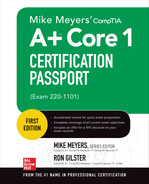
Hardware and Network Troubleshooting
Domain Objectives
• 5.1 Given a scenario, apply the best practice methodology to resolve problems.
• 5.2 Given a scenario, troubleshoot problems related to motherboards, RAM, CPU, and power.
• 5.3 Given a scenario, troubleshoot and diagnose problems with storage drives and RAID arrays.
• 5.4 Given a scenario, troubleshoot video, projector, and display issues.
• 5.5 Given a scenario, troubleshoot common issues with mobile devices.
• 5.6 Given a scenario, troubleshoot and resolve printer issues.
• 5.7 Given a scenario, troubleshoot problems with wired and wireless networks.
 Given a scenario, apply the best practice methodology to resolve problems.
Given a scenario, apply the best practice methodology to resolve problems.
The CompTIA best practice methodology, also known as the troubleshooting methodology, provides you with a process you can use to identify, solve, and document any technology problem.
As you apply this methodology in your day-to-day work (and to scenarios presented in the CompTIA A+ 220-1101 exam), remember to always consider corporate policies, procedures, and impacts before implementing changes.
The CompTIA Troubleshooting Methodology
The methodology has six steps, as shown in the following table. Note that the descriptions and the bullet points are from the official CompTIA objectives with a few comments of our own.
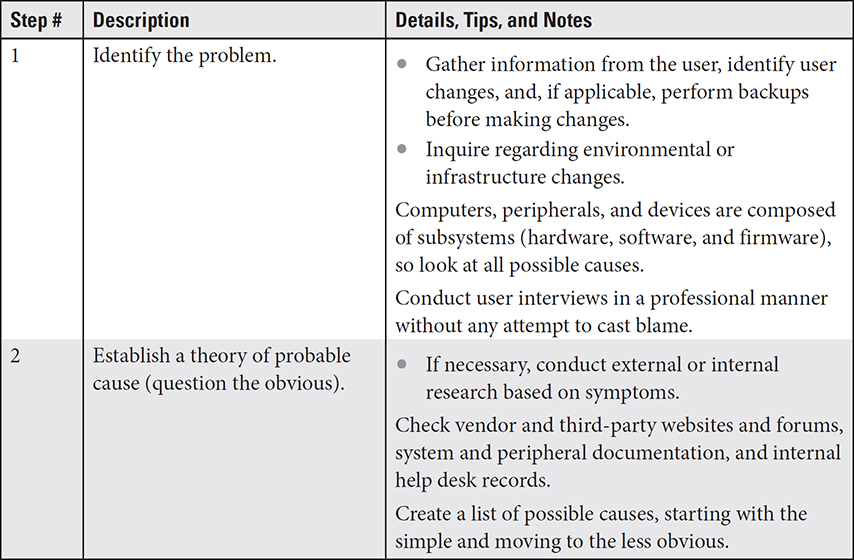
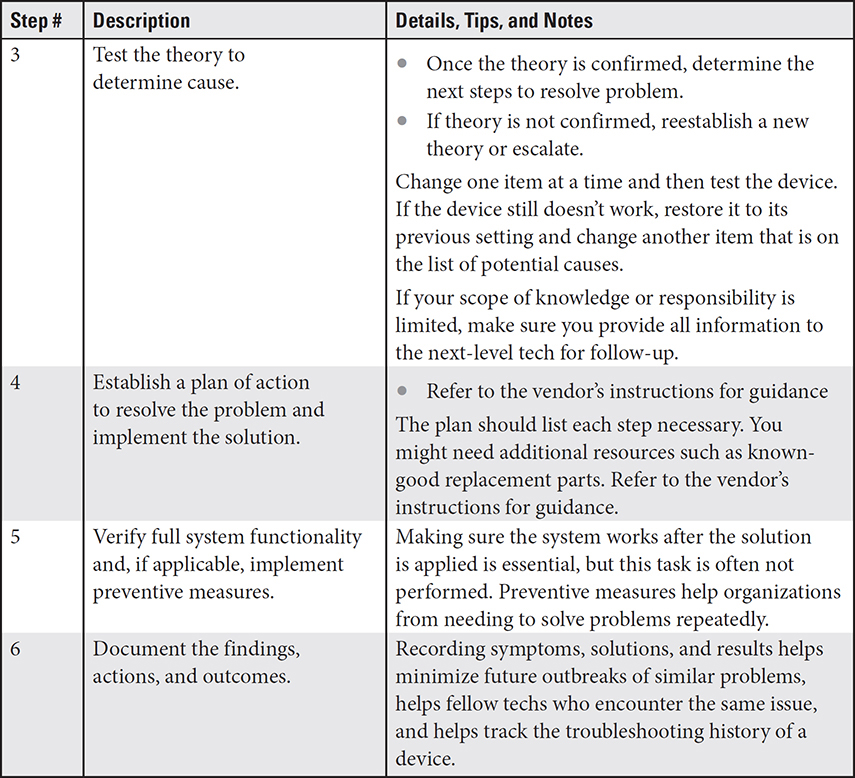

EXAM TIP It is likely you will encounter exam questions directly related to the best practice troubleshooting methodology. Know it well!
REVIEW
Objective 5.1: Given a scenario, apply the best practice methodology to resolve problems Use the six-part CompTIA best practice methodology to troubleshoot and solve technology problems:
1. Identify the problem.
2. Establish a theory of probable cause (question the obvious).
3. Test the theory to determine cause.
4. Establish a plan of action to resolve the problem and implement the solution.
5. Verify full system functionality and, if applicable, implement preventive measures.
6. Document the findings, actions, and outcomes.
5.1 QUESTIONS
1. After you establish a plan of action, what should you do next?
A. Test the theory.
B. Verify full system functionality.
C. Document findings.
D. Establish a theory of probable cause.
2. When should you question the obvious?
A. When identifying the problem
B. When documenting findings
C. When testing the theory
D. When establishing a theory
3. During the process of troubleshooting a printer problem, you created a document that lists the printer drivers needed, how you installed them, and how you tested the printers and the systems involved. Which of the following steps did you perform?
A. Documenting findings
B. Establishing a theory of probable cause
C. Verifying full system functionality
D. Testing the theory
4. Which step of the troubleshooting methodology is considered to be step 1?
A. Identify the problem.
B. Establish a theory of probable cause.
C. Test the theory to determine cause.
D. Verify full system functionality and, if applicable, implement preventive measures.
5. What should you always do first before implementing changes?
A. Conduct external and internal research based on symptoms.
B. Implement preventive measures.
C. Consider corporate policies, procedures, and impacts.
D. Establish a new theory or escalate.
5.1 ANSWERS
1. B Establishing a plan of action is step 4, and verifying full system functionality is step 5.
2. D Questioning the obvious is a part of establishing a theory of probably cause (step 2).
3. A Documenting the findings, which is the final step of the troubleshooting methodology, refers to noting in detail the solutions used and how they were applied.
4. A Identifying the problem is step 1.
5. C Always consider corporate policies, procedures, and impacts before implementing a change.
 Given a scenario, troubleshoot problems related to motherboards, RAM, CPU, and power
Given a scenario, troubleshoot problems related to motherboards, RAM, CPU, and power
Motherboards, RAM, CPUs, and power are the core components of any computer. Troubleshooting and diagnosing a computer problem should start by looking at these subsystems.
Troubleshooting Common Symptoms
Troubleshooting problems with motherboards, RAM, CPUs, and power can be difficult because these components have a number of common symptoms that can have multiple causes. In this objective, you will learn about these symptoms, typical causes, and leading solutions.
The following sections categorize common PC issues identified by one or more symptoms you may encounter on the A+ Core 1 exam (220-1101). These issues and symptoms are listed in the Core 1 exam objectives of the current exam, but a few leftovers from the previous exam (220-1001) are included because you might also see them on the current exam. Information is provided to help you identify the likely issue(s) and solution(s) for each symptom.
Power-On Self-Test Beep Codes
The very first thing a computer does when it is powered on is to run a self-test of its essential components, which are those configured in the BIOS or UEFI. This test has the obvious name of power-on self-test, or as it’s commonly called, the POST. Many later systems will display any errors they encounter, but just as many still use POST beep codes, which are just what they sound like (no pun intended). To inform you of a problem encountered during the POST, a predefined serious of internal beeps are sounded. The number of beeps and, in some cases, the length of the beep tone indicate audibly what problem the POST encountered. This problem is the first one encountered should there be more discovered later.
One long-time nuisance concerning the POST beep codes is that there is no standard format or pattern to them. Each BIOS publisher uses its own unique code scheme. So, as long as you use the same BIOS on all your computers, there’ll be no problems. Table 5.2-1 lists examples of some of the more commonly used BIOS-based POST beep code schemes.
TABLE 5.2-1 Examples of POST Beep Codes from Different BIOS Publishers

The specific beep code symptoms you should know for the test are included in the following table:


EXAM TIP You don’t need to memorize the beep code patterns, just know what they are and why you’d hear them. Also be familiar with the beep code symptoms.
Proprietary Crash Screens
The two most infamous screen displays that indicate a system halt or crash due to a serious hardware or software fault are the halt error message display with a blue backdrop, commonly called the blue screen of death, or the BSoD, on Windows operating systems, and the never-ending spinning pinwheel, commonly known as the spinning pinwheel of death, or the SPoD, on both Windows and macOS (although it’s in color on macOS).
The BSoD error typically indicates two general types of problems: device drivers and/or hardware problems. Another, less common cause is a misconfiguration with overclocking settings. An SPoD indicates on either OS that an application has stopped responding.
Another error condition display is the black screen on boot-up, which doesn’t really have a sinister sounding acronym. The issues detailed in the following table relate to this problem.
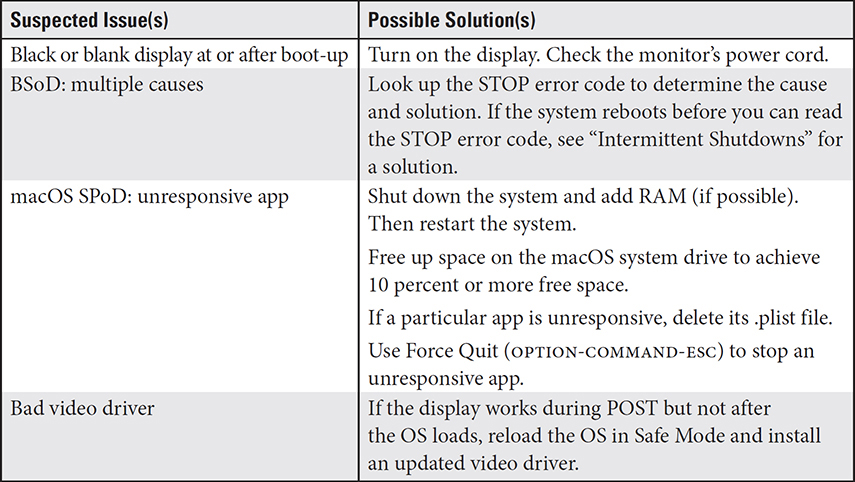
No Power
This can be one of the absolutely easiest failures to diagnose. If the computer appears to not have power, the first thing to check is that the power cord is inserted into a power source outlet. However, there are other causes, as detailed in the following table.

Sluggish Performance
There are many reasons and causes for a Windows system to run slow, lag on some actions or commands, or just run like a slug, including too many programs in the startup list, too many active programs, a damaged Registry, and the swap space being too small. The following table identifies some suspected issues and possible solutions relating to sluggish performance by a PC.

Overheating
Heat can be the mortal enemy of a computer. Too much heat can kill a CPU; too little heat can cause slow response. Even the right amount of heat, but on the wrong components, can cause a computer to perform poorly or fail altogether. The following table lists many of the suspected issues and possible solutions relating to overheating.

Burning Smell and Smoke
If you smell something like burning rubber or see smoke coming from your computer, it can’t be a good thing, but it may not be as bad as you may think. First of all, it’s not an operating temperature problem. If the computer continues to run, it must be within the monitored operating ranges. Therefore, the problem is most likely to be something else. The following table describes some possible issues and their solutions for when you smell or see smoke from a PC.

Intermittent Shutdowns
When a computer starts up, one of the system checks performed is the Power Good (PG) check. The power supply unit (PSU) checks the voltages on its output lines, and if all are carrying the correct voltages, which means the PSU is working correctly, the motherboard is sent a Power Good signal of +5 V and the boot process can continue. The following table provides possible solutions for a few of the suspected issues that may be causing a PC to shut down intermittently.
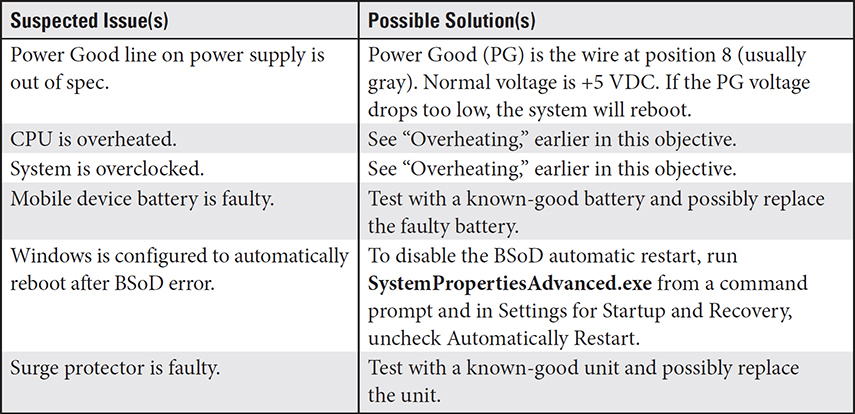
Application Crashes
If an installed application does not start, starts and then stops right away, or freezes up or “crashes” while running, but not always in the same place, you definitely have a application issue. The following table identifies a few of the issues that could be causing an application to crash and possible solutions to solve that issue.

Grinding Noise
Other than the hum of the case fan, there should be no loud noises, especially grinding noises, coming from a system case. There is typically only one major thing that could be causing the problem: the power supply or motherboard components are failing, as explained in the following table.

Capacitor Swelling
Any component on the motherboard that becomes misshaped, as in enlarged or distended, or appears to be burnt may need to be replaced, as explained in the following table.

Inaccurate System Date/Time
There is a difference between the system time (kept by the system clock) and the time displayed in the lower-right corner of the Windows GUI. If the system time fails to keep the actual data and time correctly, look at the CMOS battery. As indicated in the following table, the problem may be as simple as the motherboard battery.

Other Symptoms
The following issues and solutions are leftovers from the previous A+ Core 1 exam (220-1001), but you may still encounter them on the current (220-1101) exam.
Attempts to Boot to Incorrect Device

System Lockups

Intermittent Device Failures

Fans Spin, No Power to Other Devices

Indicator Lights

Log Entries and Error Messages


EXAM TIP Given a scenario, be prepared to identify and troubleshoot the common systems covered in this objective and listed in the following “Review” section.
REVIEW
Objective 5.2: Given a scenario, troubleshoot problems related to motherboards, RAM, CPU, and power Common symptoms of problems related to motherboards, RAM, CPUs, and power include the following:
• Power-on self-test (POST) beep codes
• Proprietary crash screens
• No power
• Sluggish performance
• Overheating
• Burning smell and smoke
• Intermittent shutdowns
• Application crashes
• Grinding noise
• Capacitor swelling
• Inaccurate system date/time
• Other symptoms:
• Attempts to boot to incorrect device
• System lockups
• Intermittent device failures
• Fans spin but no power to other devices
• Indicator lights
• Log entries and error messages
Keep in mind that each of these symptoms usually has multiple potential causes.
5.2 QUESTIONS
1. Which of the following causes for overheating can be tested in the system BIOS/UEFI settings?
A. Clogged air intakes
B. Power supply fan failure
C. Case or CPU fan speed slow
D. GPU overclocking
2. What happens if a power supply is set for 230 VAC and you connect a 115 VAC line to it and turn on the computer?
A. Overvoltage error appears on screen.
B. Computer cannot start.
C. Signal lights turn on but fans do not run.
D. Smoke and flames appear.
3. You have tested the power supply on a computer that is continuously rebooting, and the Power Good line and other voltage levels test out OK. What else should you check?
A. Whether Windows is configured to automatically reboot after a STOP error
B. Whether Windows always reboots automatically after a STOP error
C. Whether the CTRL-ALT-DEL keys on the keyboard are stuck
D. Whether the power switch on the power supply is stuck
4. What should you do if a customer’s computer resets the BIOS/UEFI time and settings incorrectly every time her computer is powered on?
A. Reset the boot sequence order.
B. Check log entries and error logs.
B. Perform a soft reset.
B. Replace the CMOS battery.
5. A customer reports that his computer keeps booting to an incorrect device. Which of the following will most likely remedy this situation? (Choose two.)
A. Change the boot order in the BIOS/UEFI.
B. Remove any nonbootable disc or USB flash drive.
C. Run System File Checker (sfc.exe).
D. Check front panel connectors and reconnect as needed.
5.2 ANSWERS
1. C The BIOS/UEFI screen, commonly called PC Health or Hardware Monitor, displays fan speeds as well as system temperature.
2. B The computer cannot start because the power supply is set for a voltage level twice what is being provided.
3. A Windows can be configured to restart the system immediately in the event of a STOP error; to enable diagnosis of the STOP error, restart the system in Safe Mode and change this setting in System properties.
4. D Power down system and replace the CMOS battery (usually a CR2032). Turn on the system, enter BIOS/UEFI setup, reset BIOS/UEFI time and settings, save your changes, and restart the system.
5. A B Enter BIOS/UEFI setup, reset the boot sequence to include the correct bootable drive, and restart. Remove nonbootable removable media and restart the system.
 Given a scenario, troubleshoot and diagnose problems with storage drives and RAID arrays
Given a scenario, troubleshoot and diagnose problems with storage drives and RAID arrays
Hard drives and RAID arrays are where programs and data alike are stored. Solving problems with these subsystems is essential to keeping workstations and servers in order.
Troubleshooting Common Symptoms
The sections in this objective present common symptoms of storage problems, along with the typical causes and leading solutions.
Light-Emitting Diode (LED) Status Indicators
![]()
Grinding Noises

Clicking Sounds

Bootable Device Not Found/Failure to Boot

Data Loss or Corruption

RAID Failure

S.M.A.R.T. Failure

Extended Read/Write Times and Read/Write Failure
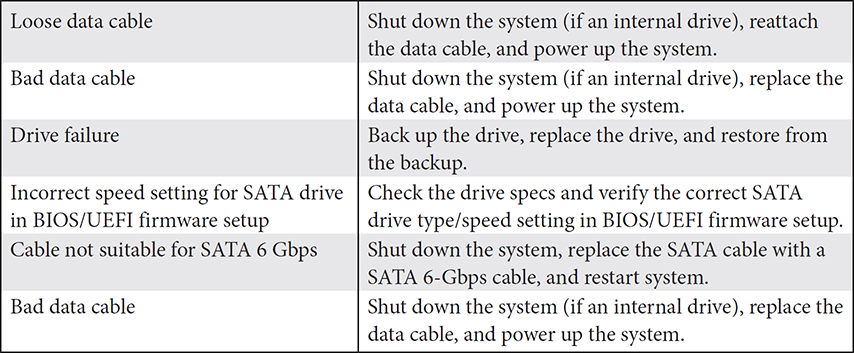

Missing Drives in OS

Other Symptoms
OS Not Found


EXAM TIP Be sure to know the symptoms, meanings, and solutions covered in this objective and listed in the following “Review” section.
REVIEW
Objective 5.3: Given a scenario, troubleshoot and diagnose problems with storage drives and RAID arrays Hard drives and RAID arrays can have a variety of problems, symptoms of which include the following:
• LED indicators
• Grinding noises
• Clicking sounds
• Bootable device not found
• Data loss/corruption
• RAID failure
• Self-monitoring, Analysis, and Reporting Technology (S.M.A.R.T.) failure
• Extended read/write times
• Missing drives in OS
• OS not found
Keep in mind that many of these symptoms can have more than one possible cause.
5.3 QUESTIONS
1. A drive in a RAID 0 array stops working. After you replace the defective drive, how can you recover from this error?
A. Rebuild the array from the working drive.
B. Restore the most recent backups to the array.
C. Use Disk Management to rebuild the array.
D. Replace both drives; the other drive will probably fail right away as well.
2. A 1-TB USB portable drive works fine on a desktop computer running Windows but will not work when plugged into a Windows laptop computer on battery power. What is the most likely cause?
A. Drive must be reformatted to be recognized by the laptop.
B. Drive is too large to be used by the laptop.
C. Laptop USB port is not providing enough power for the drive.
D. Laptop and desktop computers use different versions of Windows.
3. A computer fails to reboot after a Windows update. The update was provided on a nonbootable USB drive. Which of the following should you try first to get the computer to boot?
A. Reinstall the update from a bootable USB drive.
B. Reinstall the update from an optical disc.
C. Scan the USB drive for viruses.
D. Disconnect the USB drive and restart the computer.
4. A customer’s computer displays a “RAID not found” error on bootup. What can you do to troubleshoot this issue?
A. Free up space on the system drive to achieve 10 percent more free space.
B. Reenable the RAID controller in the BIOS/UEFI firmware or add-on card setup.
C. Repair the boot sector with OS utilities.
D. Add more RAM to the system.
5. Which of the following indicates drive failure is imminent? (Choose the best answer.)
A. S.M.A.R.T.
B. BSoD/pin wheel
C. Loud clicking noises
D. Event Viewer alerts
5.3 ANSWERS
1. B RAID 0, despite the name, does not include any redundancy; the data is striped across both drives to improve performance, and thus the loss of a single drive wipes out the array’s contents.
2. C Some laptop USB ports do not provide the full power level needed for external hard drives when running on battery power; as a workaround, some drives include a Y-cable to pull power from a second port, or the drive can be plugged into a self-powered USB hub.
3. D Some systems are configured to have a USB drive as the first bootable device to enable diagnostics or operating system installations; by disconnecting the drive, you cause the system to use the next bootable device as set in the BIOS/UEFI firmware.
4. B For “RAID not found” errors, you should reenable the RAID controller in the BIOS setup or add-on card setup. You can also try reconnecting or replacing data and power cables if you encounter loose or bad cables.
5. A S.M.A.R.T. hard drive prediction errors indicate drive failure is imminent.
 Given a scenario, troubleshoot video, projector, and display issues
Given a scenario, troubleshoot video, projector, and display issues
Desktop and laptop computer users interact with their displays as much as with their keyboards or pointing devices. Getting display problems fixed quickly is a high priority.
Troubleshooting Video, Projector, and Display Issues
The sections in this objective cover common symptoms of video, projector, and display issues, along with the typical causes and solutions.
Incorrect Data Source

Physical Cabling Issues

Burned-Out Bulb
![]()
Fuzzy or Distorted Image
![]()
Display Burn-In

Dead Pixels

Flashing Screen/Flickering Image

Incorrect Color Display

Audio Issues

Dim Image

Intermittent Projector Shutdowns

Other Symptoms
Artifacts

Distorted Geometry

Oversized Images and Icons


EXAM TIP Make sure you are familiar with the symptoms, explanations, and solutions covered in this objective and listed in the following “Review” section.
REVIEW
Objective 5.4: Given a scenario, troubleshoot video, projector, and display issues Common symptoms of video, projector, and display issues, include the following:
• Incorrect data source
• Physical cabling issues
• Burned-out bulb
• Fuzzy image
• Display burn-in
• Dead pixels
• Flashing screen
• Incorrect color displays
• Audio issues
• Dim image
• Intermittent projector shutdowns
• Other symptoms:
• Artifacts
• Distorted geometry
• Oversized images and icons
Keep in mind that many of these symptoms have multiple potential causes—and solutions.
5.4 QUESTIONS
1. A user has repositioned her desktop computer and now the display no longer has an image on the screen. However, the display and computer power lights are on. Which of the following would you have her check first?
A. Loose power cord on display
B. Pressing FN keys to go back to primary display
C. Loose video cable
D. Loose network cable
2. A Windows user reports very large text and icons on his screen. In the course of you asking the user what might be the issue, the user reported there was “some sort of an error message” during startup. Which of the following is the most likely cause?
A. System booted up in Safe Mode.
B. Video card GPU fan has failed.
C. CPU fan has failed.
D. System booted up in STOP mode.
3. You are playing a 3-D game at home and have been experimenting with getting better performance from your video card, and now you see incorrect color patterns onscreen. After checking the fan on your video card and determining it’s working properly, what should you do next?
A. Enable event logging.
B. Disable overclocking.
C. Enable Safe Mode.
D. Enable Airplane mode.
4. How would you resolve a dead pixel display issue? (Choose two.)
A. Replace the fan on the video card.
B. Replace the display if under warranty.
C. Gently message the pixel with a pencil eraser until it turns on.
D. Clean the case fans and air intakes.
5. A customer is experiencing distorted images on a display. You believe this is a result of driver corruption. Which of the following is likely to fix this?
A. Install or reinstall the latest video card drivers.
B. Replace the GPU.
C. Increase the display resolution.
D. Replace the inverter.
5.4 ANSWERS
1. C Moving the computer could cause the video cable to become loose, causing the loss of picture.
2. A Some versions of Windows automatically boot up in Safe Mode if the system didn’t boot normally on the previous boot attempt; Safe Mode uses a low screen resolution, resulting in large icons and text.
3. B Overclocking video cards or other components can lead to overheating, which is a common cause of incorrect colors onscreen.
4. B C Pixels may be dead due to manufacturing defects or being stuck in “off” mode. Replace the display if it is under warranty or gently message the pixel with a pencil eraser to see if it turns on.
5. A A common cause for distorted images is corrupted video card (GPU) drivers. You should install or reinstall the latest video card drivers.
 Given a scenario, troubleshoot common issues with mobile devices
Given a scenario, troubleshoot common issues with mobile devices
Mobile devices such as laptops, smartphones, and tablets are essential tools for today’s on-the-go workforce. When they stop working, companies stop working. This objective helps you understand typical mobile device problems and solutions.
Troubleshooting Mobile Devices
The sections in this objective cover common symptoms of mobile device issues, along with typical causes and solutions.
Poor Battery Health/Short Battery Life

Swollen Battery

Broken Screen

Improper Charging

Poor/No Connectivity
No Wireless Connectivity

No Bluetooth Connectivity

Intermittent Wireless

Liquid Damage

Overheating
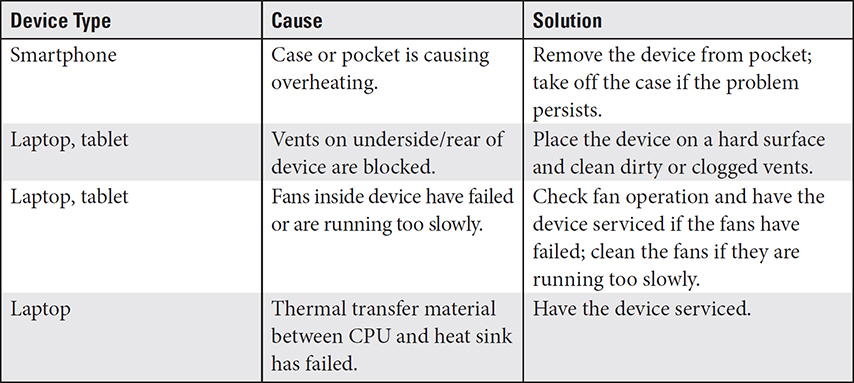
Digitizer Issues

Physically Damaged Ports

Malware

Cursor Drift/Touch Calibration

Other Symptoms
Sticking Keys

No Power

NUM LOCK Indicator Lights

Cannot Display to External Monitor

Touchscreen Nonresponsive

Apps Not Loading
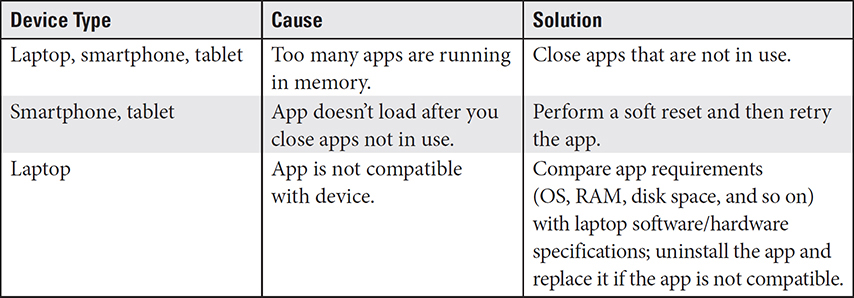
Slow Performance

Unable to Decrypt E-mail

Frozen System

No Sound from Speakers

GPS Not Functioning


EXAM TIP Be sure to know the symptoms, explanations, and solutions covered in this objective and listed in the following “Review” section.
REVIEW
Objective 5.5: Given a scenario, troubleshoot common issues with mobile devices Symptoms of common mobile device issues include the following:
• Poor battery health/short battery life
• Swollen battery
• Broken screen
• Improper charging
• Poor/no connectivity
• No wireless connectivity
• No Bluetooth connectivity
• Intermittent wireless
• Liquid damage
• Overheating
• Digitizer issues
• Physically damaged ports
• Malware
• Cursor drift/touch calibration
• Other symptoms
• Sticking keys
• No power
• NUM LOCK indictor lights
• Cannot display to external monitor
• Touchscreen nonresponsive
• Apps not loading
• Slow performance
• Unable to decrypt e-mail
• Frozen system
• No sound from speakers
• GPS not functioning
Keep in mind that many of these symptoms have multiple potential causes—and solutions.
5.5 QUESTIONS
1. A user is running a laptop computer in an office that also has an HDTV with a cable connected to the laptop. After dropping the laptop, the user can no longer see anything on the built-in display. What should you try first until you can get the laptop repaired or replaced?
A. Connect the laptop to the network and try to use remote access.
B. Have the user press the appropriate key(s) to switch to the external display.
C. Tell the user to take a day off.
D. Find an identical laptop and clone the original laptop’s Windows installation to it.
2. A laptop’s wireless connection is intermittent after it comes back from the repair shop for a screen replacement. Which of the following is the most likely cause of the problem?
A. Antenna wires are not connected properly.
B. Keyboard is stuck.
C. Wi-Fi button on the edge of the laptop was turned off during the repair.
D. Computer virus was introduced in the repair shop.
3. A customer is experiencing extremely short battery life on a mobile device. What recommendations should you make? (Choose all that apply.)
A. Close or hibernate apps running in the background.
B. Perform a hard reset on the mobile device.
C. Follow the manufacturer’s suggestions for discharging and recharging the battery.
D. Reduce the brightness of the display to help improve battery life.
4. A user finds that she is unable to use the icons on her notebook computer touchscreen to open applications. What action should she take?
A. Perform touchscreen calibration per device operating instructions.
B. Change the screen resolution.
C. Disable an active second screen.
D. Update the display’s device driver.
5. Which of the following are conditions that indicate a possibly broken screen?
A. LCD cutoff switch stuck
B. Inverter failure
C. Backlight failure
D. Inverter or backlight failure
E. All of the above
F. A and C
G. Only D
5.5 ANSWERS
1. B Most laptops can switch between the built-in display and the video port by using a Function key (sometimes requiring the user to also press the FN key).
2. A Laptops with built-in Wi-Fi use antennas mounted around the edges of the display panel and connected to the Wi-Fi card inside the body of the laptop; if these cables are not properly connected during reassembly, Wi-Fi connections will be poor or will completely fail.
3. A C D Battery life on a mobile device is dependent on the items active on the device that draw power. Another issue could be that the battery is not being charged properly.
4. A Performing touchscreen calibration will realign the sensors in the display’s touch system.
5. E Answers A, B, C, and D are all conditions that could result from a broken display screen.
 Given a scenario, troubleshoot and resolve printer issues
Given a scenario, troubleshoot and resolve printer issues
Although organizations have sought the so-called paperless office for decades, printing is still a vital part of computer use in offices of any size as well as in the home. Printer technologies vary, so it’s essential to know both the symptoms and the printer type producing the symptoms to solve printing problems.
Troubleshooting Printing Issues
The sections in this objective cover symptoms of common printing issues by printer type, along with typical causes and solutions.
Lines Down the Printed Pages

Garbled Print

Toner Not Fusing to Paper

Paper Jams

Faded Prints
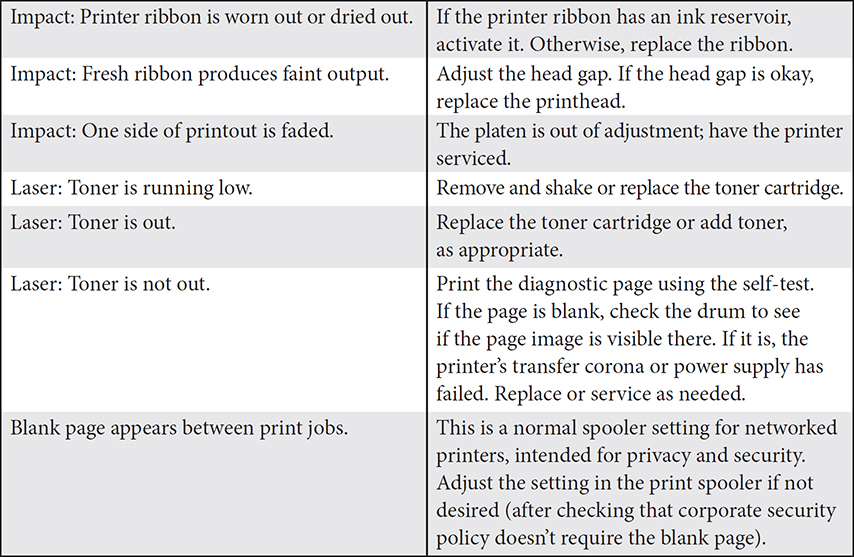
Incorrect Paper Size

Paper Not Feeding

Multipage Misfeed

Multiple Prints Pending in Queue
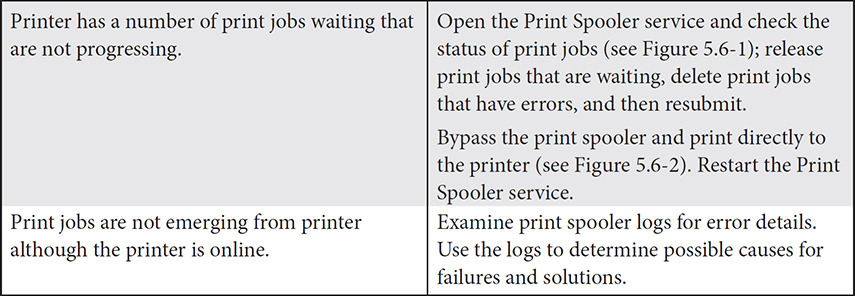

FIGURE 5.6-1 Print spooler’s print queue
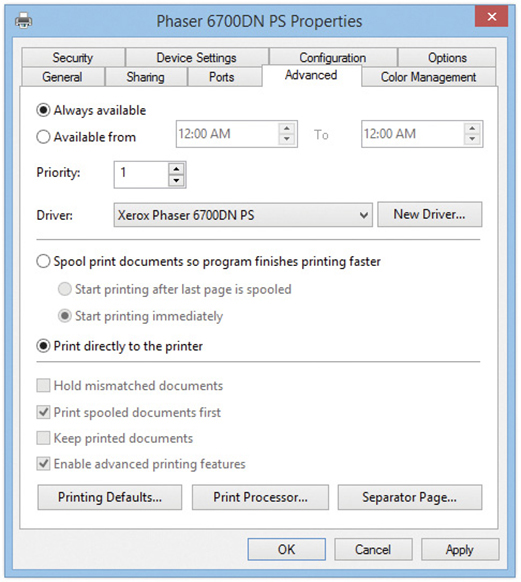
FIGURE 5.6-2 Print spool settings
Speckling on Printed Pages

Double/Echo Images on the Print
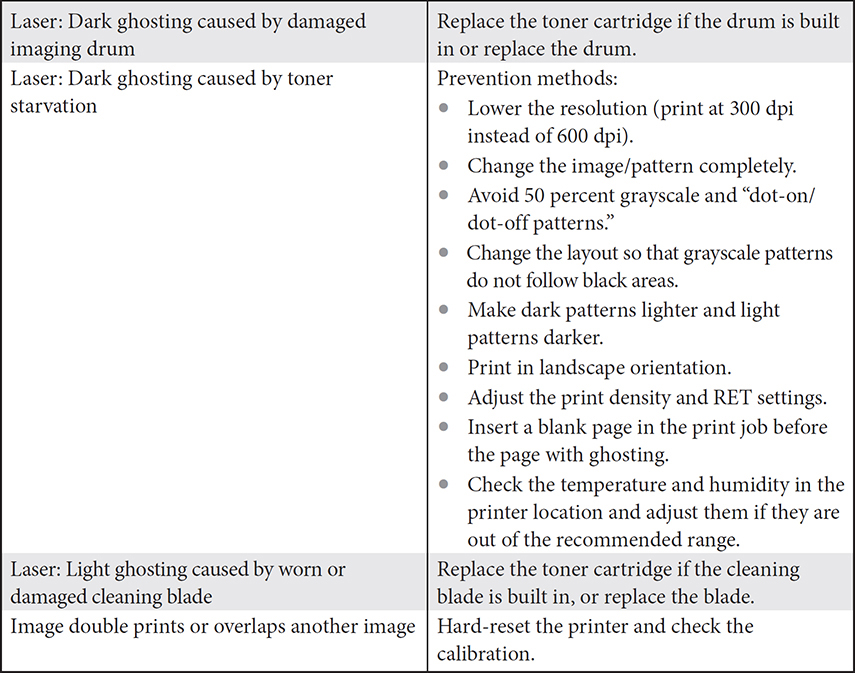
Incorrect Color Settings

Grinding Noise

Finishing Issues

Incorrect Page Orientation

Other Symptoms
No Connectivity

Low Memory Errors

Access Denied

Printer Will Not Print

Unable to Install Printer

No Image on Printer Display


EXAM TIP Make sure you are familiar with the symptoms, causes, and solutions covered in this objective and listed in the following “Review” section. Note that to solve many of these problems, you first need to correctly identify the printer type in use.
REVIEW
Objective 5.6: Given a scenario, troubleshoot and resolve printer issues Common symptoms of problems with printers of all types include the following:
• Lines down the printed pages
• Garbled print
• Toner not fusing to paper
• Paper jams
• Faded print
• Incorrect paper size
• Paper not feeding
• Multipage misfeed
• Multiple prints pending in queue
• Speckling on printed pages
• Double/echo images on the print
• Incorrect color settings
• Grinding noise
• Finishing issues
• Staple jams
• Hole punch
• Incorrect page orientation
• Other symptoms
• No connectivity
• Low memory errors
• Access denied
• Printer will not print
• Unable to install printer
• No image on printer display
5.6 QUESTIONS
1. A user is reporting that her print jobs are displaying dark ghost patterns. From this description, which of the following types of printers is in use?
A. Virtual
B. Laser
C. Impact
D. Inkjet
2. A user reports that when he prints envelopes, the envelopes are creased and misaligned. Which of the following steps is most likely to help?
A. Change the printer to single-sided printing.
B. Adjust the tractor feed.
C. Adjust the paper guides.
D. Use RET in the printer preferences.
3. A user reports paper jams at the rear of the printer when he tries to print double-sided pages. Which of the following components is most likely the cause?
A. Rear paper feed
B. Ink cartridges
C. Duplexer
D. RET
4. A laser printer is printing blank pages. Which of the following solutions should you apply to fix this problem? (Choose two.)
A. Replace the printhead.
B. Bypass the print spooler and print directly to the printer.
C. Replace toner cartridge.
D. Attempt to print a diagnostic page using self-test.
5. A user’s printer has a number of print jobs backed up and waiting in the print queue. Which of the following measures should you take to get the print jobs printing again?
A. Verify the user account has access to the printer.
B. Restart the Print Spooler service.
C. Calibrate the printer.
D. Reinstall the latest printer driver.
5.6 ANSWERS
1. B Dark ghost patterns only occur on malfunctioning laser printers.
2. C Paper guides must be set correctly for the paper or media width installed; if they are set too wide, the paper/media will not feed straight.
3. C The duplexer at the rear of the printer is used to flip the paper for printing on the reverse side.
4. C D If a laser printer prints blank pages, you should replace the toner cartridge or add toner, as appropriate. If it is not out of toner, print a diagnostic page using the self-test. If the page is blank, check the drum to see if the page image is visible there. If it is, the printer’s transfer corona or power supply has failed and should be replaced or serviced, as needed.
5. B Of the listed answers for addressing a backed-up print queue, restarting the Print Spooler service is the best option.
 Given a scenario, troubleshoot problems with wired and wireless networks
Given a scenario, troubleshoot problems with wired and wireless networks
Today’s offices, home offices, and home entertainment systems rely on networking, so the odds of running into network problems are high.
Troubleshooting Network Issues
Make the odds of solving network problems in your favor by learning the common symptoms and solutions covered in the following sections.
Intermittent Wireless Connectivity

Slow Network Speeds
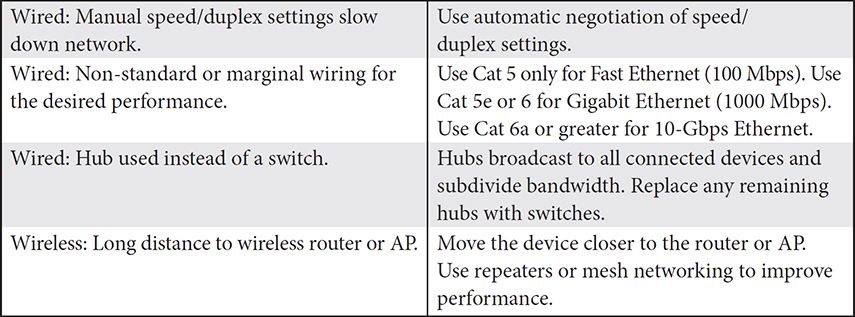
Limited Connectivity/No Connectivity

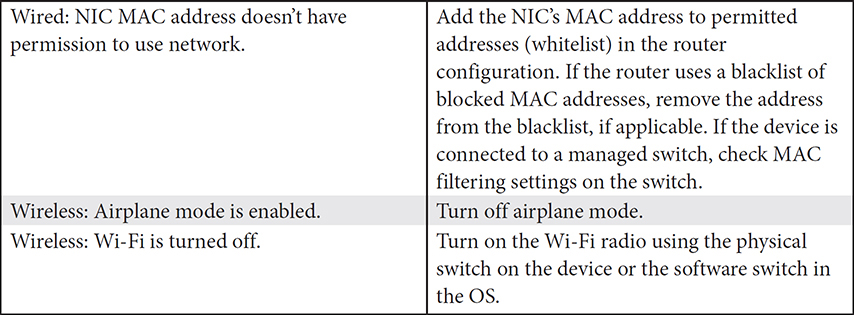
Jitter

Poor VoIP Quality

Port Flapping

High Latency
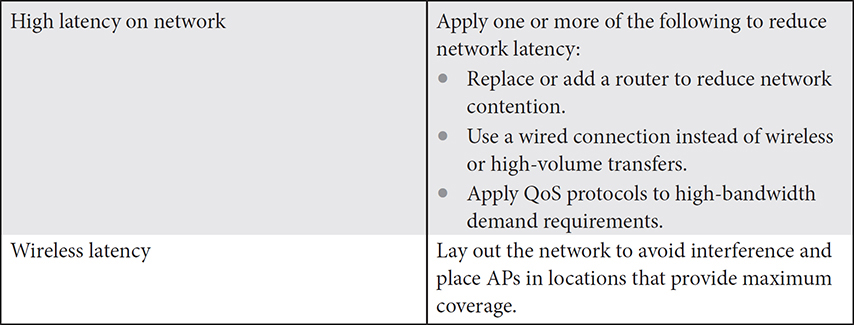
External Interference

Other Symptoms
Unavailable Resources: Internet

Unavailable Resources: Local Resources
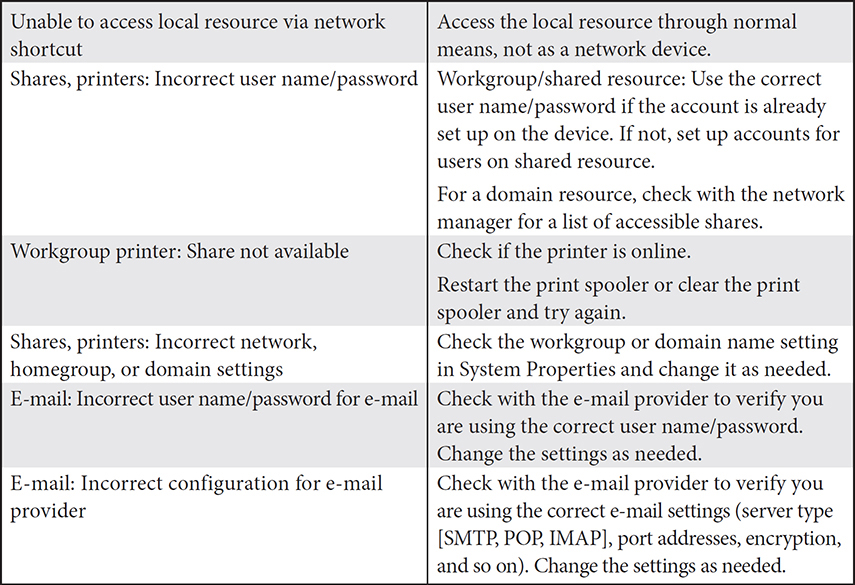
APIPA/Link Local Address

IP Conflict

SSID Not Found/Multiple SSIDs


EXAM TIP Be sure to know the symptoms, causes, and solutions for the network issues covered in this objective and listed in the “Review” section.
REVIEW
Objective 5.7: Given a scenario, troubleshoot problems with wired and wireless networks The following wired and wireless network problems can have multiple causes and, sometimes, more than one solution to try:
• Intermittent wireless connectivity
• Slow network speeds:
• Limited connectivity/no connectivity
• Jitter
• Poor VoIP quality
• Port flapping
• High latency
• External interference
• Other symptoms:
• Unavailable resources: Internet and local resources: shares, printers, e-mail
• APIPA/link local address
• IP conflict
• SSID not found/multiple SSIDs
5.7 QUESTIONS
1. Which of the following solutions possibly would not resolve a slow wireless network connection speed?
A. Moving client devices to a new location to minimize obstacles between the router and the clients
B. Changing the AP channel setting on the router to a non-overlapping channel
C. Updating the firmware and device drivers on the client and wireless AP or router
D. Removing other non-network wireless devices in the area that may use the same frequency bands
E. Changing the DHCP settings
2. What is the IPv4 address range used for APIPA assignments?
A. 169.254.0.1–169.254.255.254
B. 10.0.0.0–10.255.255.255
C. 127.0.0.1–127.255.255.255
D. 224.0.0.0–239.255.255.255
3. A workstation is able to connect to the router but is unable to obtain an IP address. Which of the following is likely the cause of this problem? (Choose all that apply.)
A. Router requires a reset.
B. Windows Fast Startup.
C. Recent update was applied to the router.
D. Internet service is not available from the ISP.
E. All of the above could be the issue.
4. What is the primary cause for poor quality service on a VoIP network?
A. Bandwidth
B. Throughput
C. Jitter
D. Transfer speed
5. Which of the following is the better solution for slow throughput on a wired network?
A. Using automatic negotiation for speed duplex settings
B. Using manual settings for speed duplex
C. Upgrading the cabling standard installed
D. Replacing all switches with hubs
5.7 ANSWERS
1. E All of the other available options could individually or together resolve speed issues on a wireless connection.
2. A IP addresses starting with “169.” are assigned automatically when an IP address cannot be received from a DHCP server.
3. E All of the options listed could be the cause of this issue.
4. C Jitter is the most common cause of issues on a VoIP connection.
5. A Automatic negotiation for speed duplex settings allows the system to regulate the transfer speed of the network.
